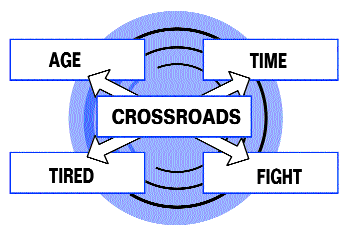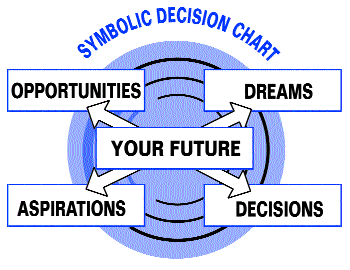Positive Health Online
Your Country

The Symbolic Decision Chart
listed in psychospiritual, originally published in issue 128 - October 2006
Distractions in a Culture of Approval
How many times have you heard or seen people staring an opportunity in the face, and then ended up wanting to tear your hair out when they failed to grab it. Have you personally ever had the opportunity to do something really special? Did you get excited about it, and then for various reasons let it go?
Distractions pervade our lives in a culture of approval. These distractions force us to make decisions on decisions that have already been made. For example, an opportunity comes along, you know as soon as you see it that it was meant for you. You can hardly control yourself; you're so excited, and then you go and tell someone about it. The next thing you know they're saying "are you sure you know what you're doing?'' This is quite natural; after all it's not their opportunity but yours!
Of course it's important to get a response from the people you deal with; the right support can give you impetus to move on with your dreams and aspirations. Sometimes though, through the fog of distraction, you can lose that instinctive awareness of the opportunities that surround you.
Charting the Path of Opportunity
What do I mean by decisions on decisions? The opportunity that you either take or hesitate at is created in a moment of inspiration. It's that instant when you say I want to do that or I want to be that. You see it and you make a decision, creating an opportunity on a path of opportunity to be taken, at the time and place you will have chosen. Can you remember dreaming of something that you wanted? Did you find yourself living the dream?
But life moves on, you get one or two knock backs and people seem to want more of your time. And yet, these opportunities seem to keep popping up, leaving you frustrated. It's not the decision that people worry about, it's the response to the opportunity created by the decision that people have difficulty dealing with.
Responding to Symbols
Symbols have always had an impact on the way people communicate. Today, images that surround us in our daily life still have a major impact on the way we communicate, the way people respond to us and the decisions we make. If you look around you, you will see countless objects that can be classed as symbols.
Try this exercise: get a sheet of paper and a pencil and make a note of ten objects you can see; take time to look at each object you make a note of, and try and measure how you feel about them.
Whether the symbol is a sign of the times, e.g. a fridge, or a symbol that's been around for thousands of years, e.g. a cup, people have responded to the symbols you see in the same way, bridging any cultural divide and uniting us all in a universal language. Your performance, your emotional response, the way you communicate, can be measured by each symbol you see.
The following are just some of the examples that you may encounter, and take for granted, in everyday life.
A red apple may lead you to choose it over a green apple. Two symbols, two responses; the apple, the colour of the apple, both have an impact on your performance, and the way you respond to the opportunities that surround you.
A cup of tea can also influence your emotional response. Having a nice cup of tea may have a calming influence on you; it can also be a social event that stimulates interaction. You can break it down further: the colour of the cup and the tea the cup holds.
Animals as symbols can have a significant impact. Various aspects come into play: the loyalty of a dog, the lack of inhibition when mating, the wild untamed aspect of animals, and much more; all can have an influence on your performance, and the way people respond to you.

Case Study Example Chart
Performance in a Culture of Approval
Your performance is your ability to communicate how you feel about yourself and others. It is reflected in your mannerisms, actions, and the pitch and tone of your voice. It's the first thing that people pick up on. When you meet someone for the first time you will instinctively make a decision on how you are going to respond to the decision they have made about themselves. You're born with this instinctive ability to perform. Whatever language, whatever culture, whatever age, we're all united in our ability to respond to each others' performance. If you see something that excites you, it will be reflected in your performance; people that you deal with will instinctively pick up on your excitement.
Understanding the significance, and influence, that symbols can have over your performance can only enhance your ability to communicate how you feel, and how people respond to your needs, and the decision you've made about yourself.
What Question can you Ask the Chart?
You can approach the chart with any question you like. It can be about a life changing decision you believe you have to make. You might have a question about a relationship, where you may wonder if he or she is the right person for you. It can even be a question about the health of someone close to you. The scope is limitless.
Using the Chart
The chart is made up of five boxes. The layout of the boxes is done in a specific way – four corner boxes and a central one. The placement of the boxes are in themselves symbolic; you will see that they are in the shape of a cross. The shape of the boxes hold a symbolic message, and this is again designed to stimulate a response.
Placing the Symbols
It's important to use the first word that comes into your head. Don't change your mind, don't water it down by trying to explain why you should use a specific symbol, go with your instincts, if it feels right you're on the right track.
The Central Theme Box
The symbol you put in this box reflects any external influences in your life. It can be a question about work, relationships, or even a question about your health. It can be about the people you deal with. It works on the principle that we all instinctively make decisions on each others' performance, including our own.
Four Corner Boxes
The symbols you use in the four corner boxes reflect your dreams and aspirations; these are your guide along the path of opportunity.
Getting the Balance
To get the reading from the five symbols you need to get the right balance. We do this by reading from top left to bottom right and bottom left to bottom right, or vice versa. The reason we don't go corner to corner is we have to bring into the equation the external influences in your life which is reflected by the symbol in the central box.
The chart reminds you that no matter what distractions you may have in life, if you stay alert to your true self, you can respond in a positive way to the opportunities that surround you.
Case Study
This case study looks at a reading that I did for a male who asked a question about the direction he wanted to take in life.
Central Theme: Crossroads
To reach the crossroads is to come face-to-face with the unknown and, since the natural human reaction to the unknown is one of fear, the primary aspect of the symbol is anxiety. Crossroads show that a parting of the ways has been reached, and that one must take a new and decisive response to the direction in one's affairs. The crossroads is not the end; it is merely a pause and an invitation to go on. Once the choice has been made there is no going back.
Note: Crossroads have always had a symbolic impact on people's lives. They show that culturally, people have always found decision-making challenging.
Top left box: Age
See also: Fight Symbolically, age has always been regarded as a sign of wisdom, longevity and experience.
Note: In modern terms, growing old is generally looked on with disdain amongst the younger generation. Universally though, age and growing old can only be a positive and natural progression.
Top right box: Time
See also: Tired Time is often symbolized by a circular shape, describing the circle of life moving round. The centre of such circles is regarded as the motionless aspect of existence, the pivot which makes the motion of existence possible, and the one contrasting with the other like time with eternity.
Note: in relationships, be it personal or business, there is always a sense of déjà vu, having been here before.
Bottom left box: Tired
See also: Time Feeling tired suggests that you're responding in a negative way to external influences.
Bottom right box: Fight
See also: AgeFor the individual the word fight means the internal struggle. That which aims to compress the scattered world of appearance and illusion into the concentrated world of the single reality, the abundant into the one, disorder into order.
Interpreting the Reading
The chart suggested he was hesitating when opportunities appeared. The central symbol crossroads suggested confusion in which direction to take. Although age should be looked at as a positive symbol, the balance was being upset by the influence of crossroads and fight which pointed to negative external influences. The balance between tired and time going through crossroads again showed his frustration at his situation.
We discussed how he could improve is performance by creating a new scenario.
Ancient and Modern Symbols
It's important to emphasize the connection between the ancient and the modern when it comes to reading the chart. In a chaotic world the chart creates a sense of perspective, a feeling of belonging, of not being alone. It shows that no matter how technologically advanced we become we still need to connect to each other and one's own core beliefs. And to remember that the key discipline in life is not being distracted by external influences to the detriment of the path of opportunity created in your dreams and aspirations.
References
Chevalier J and Gheerbrant A. Dictionary of Symbols. Penguin Books. GB. 0-140-51254-3.
Comments:
-
No Article Comments available
